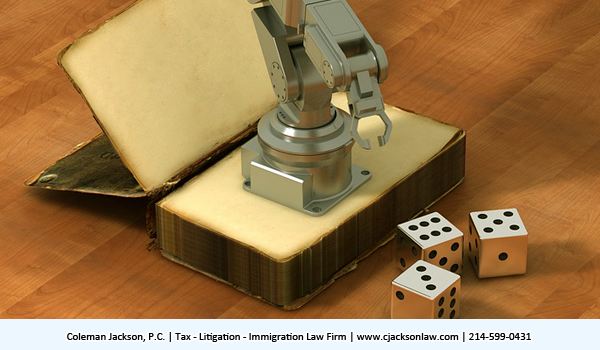By Coleman Jackson, Attorney, CPA
January 13, 2018
The 2017 Tax Cuts and Jobs Act became law during the closing days of 2017. This blog will look at these significant tax law changes from the perspective of a practicing tax professional’s point-of- view. We are not interested in discussing in any details the political, social, macro-economic or other aspects of the Tax Cuts and Jobs Act of 2017. We leave those types of analysis of the new tax law to others who have the credentials or those who think they have the credentials to critic the law’s impacts on politics, society or macro-economic policies. So with the scope of this tax blog defined, let’s explore the practical implications of the Tax Cuts and Jobs Act’s effects, or likely effects on individuals, businesses and entities with respect to tax compliance and potential for tax planning from a tax professional’s viewpoint.
Where do we start? The 2017 Tax Cuts and Jobs Act is a massive piece of legislation that touches the entire Internal Revenue Code. We are simply going to pick and choose certain aspects of the new tax law to discuss in this blog; otherwise, we run the risk of writing a blog of more than 1000 pages rivaling the length of the Tax Cuts and Jobs Act itself. Since this is a practical blog, we will not be discussing in any details, or lamenting over or even comparing what use to be the tax law. That means we will not be discussing in details anything that the Tax Cuts and Jobs Act repealed or eliminated. We are only interested in analyzing the compliance and planning opportunities that the new tax law provides now because tax practitioner’s must deal with what is and not get tangled up in the ropes of the past nor get lost in the woods thinking about what the law should have been or what the law could have been. So if you want to explore the practical aspects of the Tax Cuts and Jobs Act; let’s go on a no-nonsense journey through the Tax Cuts and Jobs Act.
Let’s start with tax brackets. In general a bracket is a continuum, which means it’s a start point and stop point. So what is a tax bracket? A tax bracket is no more than a continuum that determines how much a taxpayer has to pay in taxes. We are talking about how much money the government is going to take from the taxpayer. Each continuum is like a money bucket (a taxpayer is either in one bucket or they are in another bucket). The tax rate for each bucket is different. With tax planning a taxpayer can intentionally and lawfully move from one bracket to another. Also tax brackets are based on taxable income and not gross income; that simply means that taxable income is a net figure after considering all lawful tax deductions and credits available to the taxpayer. Whenever the taxpayer’s proper tax bucket is determined after proper tax planning and application of all the provisions of the law, the taxpayer’s tax bucket is determined and is applied to income, gift, estate and other tax basis. All kinds of exceptions arise in tax law; so, application of these simple principals; although it seems like they should be simple, actually tax planning and tax compliance is very complicated. Taxpayer’s should not pay any more taxes than they lawfully owe. For instance, how should one deride the value of a taxpayer’s estate? What assets are included in the estate, what assets are excluded from the estate; and what assets could be excluded or included under the law with proper estate planning? Under the Tax Cuts and Jobs Act, estates up to $2,000,000 are excluded from estate taxes. That means estates up to $2,000,000 can be transferred or bequeathed without the incurrence of any death taxes. We are going to essentially limit our discussion in this blog to income taxes of individuals and businesses. The 2017 Tax Cuts and Jobs Act created essentially seven tax buckets, with several exceptions or modifications thrown in here and there, as follows:
Individuals:
| MARRIED INDIVIDUALS FILING JOINT RETURNS AND SURVIVING SPOUSES | |||
| Bracket Threshold Income Levels | Applicable Tax Rate | Taxpayer | Comments |
| Not greater than $19,050 | 10 Percent of Taxable Income | Joint Filers & Surviving Spouses | Thresholds are adjusted annually based on chained CPI |
| Over $19,050 but not over $77,400 | $1,905 plus 12% of the amount over $19,050 | Joint Filers & Surviving Spouses | Thresholds are adjusted annually based on chained CPI |
| Over $77,400 but not over $165,000 | $8,907 plus 22% of the amount over $77,400 | Joint Filers & Surviving Spouses | Thresholds are adjusted annually based on chained CPI |
| Over $165,000 but not over $315,000 | $28,179 plus 24% of the amount over $165,000 | Joint Filers & Surviving Spouses | Thresholds are adjusted annually based on chained CPI |
| Over $315,000 but not over $400,000 | $64,179 plus 32% of the amount over $315,000 | Joint Filers & Surviving Spouses | Thresholds are adjusted annually based on chained CPI |
| Over $400,000 but not over $600,000 | $91,379 plus 35% of the amount over $400,000 | Joint Filers & Surviving Spouses | Thresholds are adjusted annually based on chained CPI |
| Over $600,000 | $161,379 plus 37% of the amount over $600,000 | Joint Filers & Surviving Spouses | Thresholds are adjusted annually based on chained CPI |
| Note that the income bracket thresholds are indexed for chained Consumer Price Index (CPI), which is based on the measure of inflation, which means the taxable income thresholds for 2018 and afterward would be different than the thresholds set in 2017 when the Tax Cuts and Jobs Act was enacted into law. | |||
Individuals:
| HEADS OF HOUSEHOLDS | |||
| Bracket Threshold Income Levels | Applicable Tax Rate | Taxpayer | Comments |
| Not greater than $13,600 | 10 Percent of Taxable Income | Precise Tax Rules Defines How An Individual Qualifies as a Head of Household- They Must Be Met | Thresholds are adjusted annually based on chained CPI |
| Over $13,600 but not over $51,800 | $1,360 plus 12% of the amount over $13,600 | See above comment | Thresholds are adjusted annually based on chained CPI |
| Over $51,800 but not over $82,500 | $5,944 plus 22% of the amount over $51,800 | See above comment | Thresholds are adjusted annually based on chained CPI |
| Over $82,500 but not over $157,500 | $12,698 plus 24% of the amount over $82,500 | See above comment | Thresholds are adjusted annually based on chained CPI |
| Over $157,500 but not over $200,000 | $30,698 plus 32% of the amount over $157,500 | See above comment | Thresholds are adjusted annually based on chained CPI |
| Over $200,000 but not over $500,000 | $44,298 plus 35% of the amount over $200,000 | See above comment | Thresholds are adjusted annually based on chained CPI |
| Over $500,000 | $149,298 plus 37% of the amount over $500,000 | See above comment | Thresholds are adjusted annually based on chained CPI |
| Note that the income bracket thresholds are indexed for chained Consumer Price Index (CPI), which is based on the measure of inflation, which means the taxable income thresholds for 2018 and afterward would be different than the thresholds set in 2017 when the Tax Cuts and Jobs Act was enacted into law. | |||
Individuals:
| SINGLE INDIVIDUALS | |||
| Bracket Threshold Income Levels | Applicable Tax Rate | Taxpayer | Comments |
| Not greater than $9,525 | 10 Percent of Taxable Income | Unmarried Individuals Other Than Surviving Spouses and Heads of Households | Thresholds are adjusted annually based on chained CPI |
| Over $9,525 but not over $38,700 | $952.50 plus 12% of the amount over $9,525 | See above comment | Thresholds are adjusted annually based on chained CPI |
| Over $38,700 but not over $82,500 | $4,453.50 plus 22% of the amount over $38,700 | See above comment | Thresholds are adjusted annually based on chained CPI |
| Over $82,500 but not over $157,500 | $14,089.50 plus 24% of the amount over $82,500 | See above comment | Thresholds are adjusted annually based on chained CPI |
| Over $157,500 but not over $200,000 | $32,089.50 plus 32% of the amount over $157,500 | See above comment | Thresholds are adjusted annually based on chained CPI |
| Over $200,000 but not over $500,000 | $45,689.50 plus 35% of the amount over $200,000 | See above comment | Thresholds are adjusted annually based on chained CPI |
| Over $500,000 | $150,689.50 plus 37% of the amount over $500,000 | See above comment | Thresholds are adjusted annually based on chained CPI |
| Note that the income bracket thresholds are indexed for chained Consumer Price Index (CPI), which is based on the measure of inflation, which means the taxable income thresholds for 2018 and afterward would be different than the thresholds set in 2017 when the Tax Cuts and Jobs Act was enacted into law. | |||
Estates & Trusts:
| ESTATES AND TRUSTS | |||
| Bracket Threshold Income Levels | Applicable Tax Rate | Taxpayer | Comments |
| Not greater than $2,550 | 10 Percent of Taxable Income | This is a tax on increments of wealth on assets held by trust, such as, dividend income, interest income and so forth. It also applies to estates over $2,000,000 transferred at death of a decedent. | Thresholds are adjusted annually based on chained CPI |
| Over $2,550 but not over $9,150 | $255 plus 24% of the amount over $2,550 | See above comment | Thresholds are adjusted annually based on chained CPI |
| Over $9,150 but not over $12,500 | $1,839 plus 35% of the amount over $9,150 | See above comment | Thresholds are adjusted annually based on chained CPI |
| Over $12,500 | $3,011.50 plus 37% of the amount over $12,500 | See above comment | Thresholds are adjusted annually based on chained CPI |
| Note that the income bracket thresholds are indexed for chained Consumer Price Index (CPI), which is based on the measure of inflation, which means the taxable income thresholds for 2018 and afterward would be different than the thresholds set in 2017 when the Tax Cuts and Jobs Act was enacted into law. | |||
What’s in the Tax Cuts and Jobs Act for Businesses?
Net income distributed by a pass-through entity to an owner or shareholder may be treated as “business income” subject to a maximum tax rate of 20 percent, instead of ordinary income. The excess business income would be treated as compensation to the owner’s of the pass-through-entity and is taxed at the business owner or shareholder’s individual tax rates. Not all businesses are pass-through-entities. What is a past-through-entity? A Pass-through-entity is a business structure that is not taxed on its profit and losses; but, the profit and losses of the business enterprise passes through to the owner or shareholders of the business entity. Some types of business structures that are pass-through-entities are general partnerships, joint ventures, sub-chapter S Corporations, and multi-member Limited Liability Companies. Single member Limited Liability Companies, Chapter C Corporations and Sole-Proprietorships are not pass-through-entities. Businesses need to be properly structured, not only from a tax perspective but also liability purposes and other non-tax purposes. Business owners may benefit from restructuring their businesses into pass-through- entities under the Tax Cuts and Jobs Act of 2017. However, structuring, dissolution and restructuring of a business enterprise is a major undertaken with significant potential tax consequences to both the individual owners and the business entity. Such entity choice selections should be done with precision and skill in organizational as well as tax law because actual application of the pass-through-entity provisions set forth in the Tax Cuts and Jobs Act are complicated; things like shareholder’s tax elections, capital account percentages, tax recapture rules, level of activity or involvement in the business, complexities associated with personal service businesses and real estate investment trusts (REIT), patronage dividends from cooperatives, state law requirements and regulations are hurdles and challenges confronting business owners when structuring, dissolving and restructuring business enterprises. Choice of business entity is a critical decision that business owners, venture capitalist and other entrepreneurs must make that have obvious tax consequences that are not made any simpler by the Tax Cuts and Jobs Act. Many other legal and business factors; other than tax, must be taken into consideration when making choice of business entity decisions. There are other business benefits in the Tax Cuts and Jobs Act too; one of significant ones is the accelerated expensing of capital expenditures rather than capitalizing them and amortizing them over time. Other business benefits in the Tax Cuts and Jobs Act are much more esoteric.
What’s in the Tax Cuts and Jobs Act for individuals?
We are not going to focus on what has been taken away in its entirety or drastically reduced, but we will mention some that could be significant depending on a taxpayer’s overall circumstances; such as, mortgage interest on a home equity loan (that’s gone); personal exemption (that’s gone); the requirement to purchase health insurance (that’s gone); residential property taxes and residential property interest (combined they are capped at $10,000 maximum); alimony deduction (that’s gone too). The child tax credit has been increased to $2,000 per qualifying child with an increased phase out amount. The standard deduction for married are increased to $24,000 and $12,000 for singles respectfully (but factor in the fact that the personal exemption is gone). The child tax credit seems to be among the most favorable benefits to individuals; maybe tax wise it is; but, after considering all the multifaceted factors and costs of large families today in an increasingly global and technological world, maybe the child tax credit is not the most favorable tax-benefit in the Tax Cuts and Jobs Act for families and individuals.
The Tax Cuts and Jobs Act is sure to be dissected by tax practitioners for years to come as related tax regulations, rulings, decisions, tax policies are published and implementation of the new law goes forward. Interested persons should follow our blogs as we have only highlighted a few things in this blog out of the Tax Cuts and Jobs Act. The Tax Cuts and Jobs Act consists of over 1000 pages of tough reading. It will take awhile to assemble this puzzle.
This law blog is written by the Taxation | Litigation | Immigration Law Firm of Coleman Jackson, P.C. for educational purposes; it does not create an attorney-client relationship between this law firm and its reader. You should consult with legal counsel in your geographical area with respect to any legal issues impacting you, your family or business.
Coleman Jackson, P.C. | Taxation, Litigation, Immigration Law Firm | English (214) 599-0431 | Spanish (214) 599-0432




